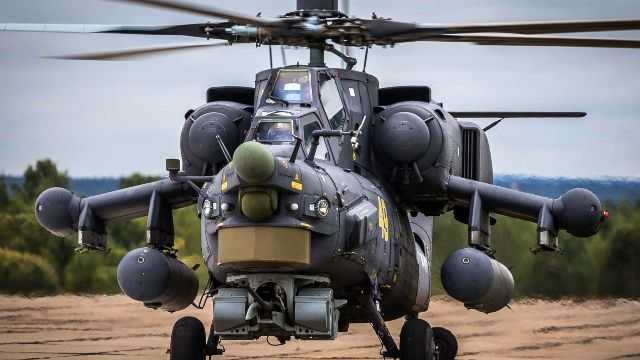
Russia sends Mi-28NM with Ataka ATGM against Leopard and Abrams
Keep up to Date & Bypass the Big Tech Censorship
Get uncensored news and updates, subscribe to our daily FREE newsletter!
Russia will react to reports that Ukraine expects the delivery of Western tanks. Challenger 2 and Leopard will come from Kyiv’s European allies, and Washington will send Abrams. Logically, Moscow will not be idle and began to show it, immediately after the news of future supplies to Ukraine.
An upgraded Mi-28NM helicopter was spotted in Ukraine on January 14, days before the decision to deliver tanks to Kyiv was made. For the first time, this version was used in combat in Syria, nearly five years ago.
Russia is apparently impressed with the helicopter, as it ordered 100 units. They should enter service in 2027. The Mi-28NM has been spotted in Ukraine with a new weapon – the 9M120 anti-tank guided missile nicknamed the Ataka.
| Recommended Books [ see all ] | ||||
|---|---|---|---|---|
 |  |  |  |
 |
What do we know about the Mi-28NM?
The new cabin is air-tight, ventilated, air-conditioned, and has armor protection [including a front armored glass that can withstand 12.7mm bullets]. And armored partitions between crew members minimize the possibility of simultaneous death of both pilots. The hull armor can withstand up to 20mm rounds.
In this type of helicopter, for the first time, the two crew members are separated – the pilot and the operator-navigator.
In an emergency situation at an altitude of more than 100 m, the crew can leave with parachutes and, falling from a height of less than 100 m, the energy of the impact is compensated by deformation of the landing gear and special energy-absorbing seats for the pilots. The emergency ejection system is activated separately by the pilot and pilot operator.
For the safety of the crew in case of accidents, the doors of the cabin are removed and escape ladders are inflated by which the pilots leave the helicopter. In addition, there is an additional compartment with two or three places for emergency evacuation of crews from crashed helicopters.

Mi-28NM in combat conditions
“The Mi-28NM is the latest modification of the Mi-28N. Its capabilities have been expanded, including maneuverability. The machine can use high-precision weapons and has a new control system with elements of artificial intelligence. The Mi-28NM can be used in the formation and quickly interacts with other helicopters, drones, and flying machines on the battlefield,” says a Russian expert Dmitry Litovkin.
As he noted, the helicopter’s armament also includes kamikaze drones. “The Mi-28NM enters a given area and launches one or several drones controlled by the helicopter. When enemy objects are detected, the crew issues target instructions and monitors the elimination of the objects,” says the expert.
The helicopter can operate in simple and complex weather conditions, and fly in manual and automatic mode with terrain lap. One of the important changes for Mi-28NM pilots is dual control, when in case of injury or death of the pilot, the helicopter will be able to be controlled by the navigator. There is no such system in the Mi-28N.
Battle systems for all times
The complex allows the use of weapons at any time and in any weather conditions, providing the possibility of group use of helicopters in battle, with the distribution of targets among them, as well as with the exchange of information about targets between helicopters and air or ground command posts.

The pilot is fully integrated into the helicopter control system. He gets a comprehensive view of the battlefield situation thanks to devices and systems.
The Mi-28NM also has a new locator [onboard radar] that provides a circular overview [located in a spherical fairing above the axis of the main rotor]. It allows scanning of the airspace in a range of 90 degrees [horizontal] and 44 degrees [vertical] and detects various targets without unmasking the helicopter. Thus the lives of the crew are at less risk.
The complex also includes a high-frequency inertial navigation system that allows determining the location, speed, course, and other parameters of the helicopter; an on-board diagnostics system and multifunctional color indicators, as well as equipment for interaction with unmanned aerial vehicles. All onboard equipment controls are integrated into a single system.
9M120 Ataka
The 9M120 Ataka missile has already been spotted under the wings of the Russian Mi-28NM helicopter in Ukraine. It was designed in the 80s of the last century. It is especially valued by the Russian Air Force because of its long-range – up to 25 km. 9M120 Ataka has passed state and real combat tests in Syria.

The characteristic of the 9M120 Ataka is its combined guidance – inertial, satellite, and optical guidance. The missile is designed specifically for air countermeasures against heavily armored combat vehicles – tanks, armored personnel carriers, anti-tank self-propelled guns, etc.
The Mi-28NM can fire two different variants of the 9M120 Ataka. The first version is a two-stage missile with a tandem warhead. The second version is a missile with the missile, but it is designed to be launched from a ground-based launcher.
The Ataka missile is housed in a glass-reinforced plastic tube that also serves as its launcher. Its eventual opposition to Western tanks expected to arrive in Ukraine could accelerate the export of the missile. Algeria, Iraq, and Uganda are currently showing interest in it.
Source: https://tinyl.io/7lsH


